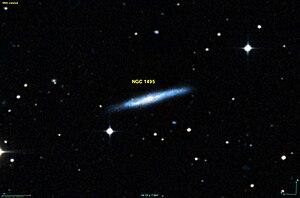NGC 1495
| Galaxy NGC 1495 |
|
|---|---|

|
|
| AladinLite | |
| Constellation | Pendulum clock |
|
Position equinox : J2000.0 , epoch : J2000.0 |
|
| Right ascension | 03 h 58 m 21.8 s |
| declination | -44 ° 27 ′ 59 ″ |
| Appearance | |
| Morphological type | Sc? / sp |
| Brightness (visual) | 12.6 mag |
| Brightness (B-band) | 13.3 mag |
| Angular expansion | 3.00 ′ × 0.5 ′ |
| Position angle | 105 ° |
| Surface brightness | 12.9 mag / arcmin² |
| Physical data | |
| Redshift | 0.004282 ± 0.000020 |
| Radial velocity | 1284 ± 6 km / s |
|
Stroke distance v rad / H 0 |
(51 ± 4) · 10 6 ly (15.5 ± 1.1) Mpc |
| history | |
| discovery | John Herschel |
| Discovery date | October 24, 1835 |
| Catalog names | |
| NGC 1495 • PGC 14190 • ESO 249- G034 • MCG -07-09-004 • IRAS 03567-4436 • 2MASX J03582180-4427585 • SGC 035644-4436.5 • GC 797 • h 2602 • LDCE 0266 NED018 / 19 | |
NGC 1495 is a spiral galaxy of Hubble type Sc in the constellation pendulum clock on the southern sky , the estimated 51 million light-years from the Milky Way 's center.
The object was discovered by the astronomer John Herschel on October 24, 1835 with his 47.5 cm reflecting telescope .
